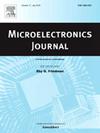A broadband GaAs receiver MMIC for W-band applications
IF 1.9
3区 工程技术
Q3 ENGINEERING, ELECTRICAL & ELECTRONIC
引用次数: 0
Abstract
A broadband, multifunctional W-band receiver MMIC (Monolithic Microwave Integrated Circuit) is presented, designed using 0.1-m GaAs pHEMT (pseudomorphic high-electron-mobility transistor) technology from WIN Semiconductors. This MMIC integrates a sextupler, a quadrature resistive mixer, and a low-noise amplifier (LNA), with the sextupler and LNA individually fabricated and tested to optimize performance. Several technologies were employed to enhance the performance of the receiver MMIC. First, a parallel-line coupler, acting as a high-pass filter, reduces lower-order harmonics in the LO chain. Second, radial stubs are applied to chock DC paths in the LO chain for broadband operation. Third, an on-chip LC low-pass filter is incorporated in the IQ mixer to achieve a broad intermediate frequency (IF) bandwidth while minimizing LO signal leakage to the IF port. Measurement results demonstrate a conversion gain of 7–9.5 dB and a noise figure of 5.1–8 dB across an 85–115 GHz frequency range. Compared to other W-band receivers utilizing III-V semiconductor technologies, this GaAs-based receiver MMIC offers a broader operating bandwidth and a competitive noise figure, all within a compact size of . These attributes make it highly suitable for various W-band applications, including wireless backhaul, radiometry, and millimeter-wave imaging.

求助全文
约1分钟内获得全文
求助全文
来源期刊

Microelectronics Journal
工程技术-工程:电子与电气
CiteScore
4.00
自引率
27.30%
发文量
222
审稿时长
43 days
期刊介绍:
Published since 1969, the Microelectronics Journal is an international forum for the dissemination of research and applications of microelectronic systems, circuits, and emerging technologies. Papers published in the Microelectronics Journal have undergone peer review to ensure originality, relevance, and timeliness. The journal thus provides a worldwide, regular, and comprehensive update on microelectronic circuits and systems.
The Microelectronics Journal invites papers describing significant research and applications in all of the areas listed below. Comprehensive review/survey papers covering recent developments will also be considered. The Microelectronics Journal covers circuits and systems. This topic includes but is not limited to: Analog, digital, mixed, and RF circuits and related design methodologies; Logic, architectural, and system level synthesis; Testing, design for testability, built-in self-test; Area, power, and thermal analysis and design; Mixed-domain simulation and design; Embedded systems; Non-von Neumann computing and related technologies and circuits; Design and test of high complexity systems integration; SoC, NoC, SIP, and NIP design and test; 3-D integration design and analysis; Emerging device technologies and circuits, such as FinFETs, SETs, spintronics, SFQ, MTJ, etc.
Application aspects such as signal and image processing including circuits for cryptography, sensors, and actuators including sensor networks, reliability and quality issues, and economic models are also welcome.
 求助内容:
求助内容: 应助结果提醒方式:
应助结果提醒方式:


